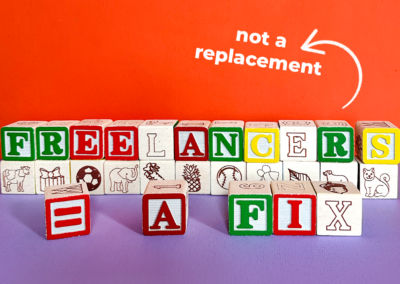Looking at the org chart, it looks like someone took a typical chart with neatly organized lines, bubbles, roles, and reporting structures, then randomly put four blue dot stickers on it. Each of those stickers has my name on it.
To work at a startup is to love change.
A startup is a constantly adapting organism, learning and reorganizing based on new information. Some shifts are as big as business model pivots, others are more specific, like quarterly OKRs and KPIs. Changes impact projections, numbers, outcomes. They also impact the team and individual dynamics. Some affect the entire culture of the organization.
I have been involved with the startup MyVillage for three years. I love the leadership, the team, and the mission (“To harness the power of community to create exceptional care for every child.”) I love the complexity of trying to reimagine the entire industry of childcare. I love the scale of the problem and the equal and opposite scale of the impact.
In order for me to be successful at MyVillage in what I do (community, culture, content), I became a shapeshifter. Within my three years I have been a contractor, a full-time employee, a part-time employee, on an extended leave of absence, on several teams (sometimes at once), and have had multiple direct reports. I am a layered workforce of one.
Meeting the moment
This was not an accident. Each of my roles was intentionally designed to meet the moment. When I say “meet the moment,” the moment could be in the world, at the company, and for myself.
I began as a contractor dipping my toes into the project at a very high level. I helped with customer journey mapping, team building, and strategy. I had no intention of joining the team because I love consulting. The CEO convinced me otherwise.
I joined full time, but I stepped onto the executive team with a newly-created and intentionally vague title of Chief Community Officer. A year into that role (which overlapped with almost every team in the organization) I took an unexpected and extended leave of absence to care for my dying mother. Coming back from that leave we entered the pandemic and the roller coaster of remote work, no travel, and other adaptations.
Making it work
How does this shifting role work? Does this work? Both are fair questions. In order to be simultaneously successful and add value while moving around the org chart I needed to be:
Deeply authentic.
I had to be honest, vulnerable, and transparent about what was and was not working. My CEO had to match this level of transparency. The success of a shapeshifting role is inherently tied to a commitment to honesty from all sides.
Nimble
“Hold it lightly” and “Add value” were my twin mantras. Part of an ever-shifting role is the ability to not need to control every aspect of a project, yet stay focused on adding value wherever I land.
Humble
Sometimes I had direct reports, sometimes I was reporting to someone else on the exec team. I alternated between being lead on a project to being one of multiple contributors. Staying open to learning in all roles is key.
And most important:
Focus on the big picture
All of the above is only possible by staying focused on the larger mission and vision. It is so easy to get swept up in short-term experiments and medium-term metrics that it starts to feel like those are the business. There is a distinction between day-to-day work and impact. Focusing on the impact keeps authenticity, nimbleness, and humility in check
It takes a special company to work this way. The right company needs to be:
- Equally as honest about needs. The clearer the company can get on what value looks like, what is needed, and what might be coming up, the better this arrangement will work.
- Willing to adapt. Even though startups are all about change, some of them really struggle with it. Finding a company that loves adaptation will make this concept really exciting for both sides.
- Committed to the ongoing value-add of the worker — they believe in you
- Have clear systems for adjusting the compensation structure (otherwise shifting in and out of payroll, benefits, etc will make it not feel worth the effort)
Benefits of a flexible role:
I benefited by being able to adjust my time based on the ever changing needs of my family, but also of my own goals. I have been able to dive deep into this project, learn, and roll up my sleeves. And sometimes, I have been able to focus elsewhere in my career, like now, as I am working part-time while writing my first book.
The company benefited by being able to dial up or dial down the expense of having me on the team based on the immediate needs, without me stepping so far away that I lost sight of the big picture or pivots. Benefits to the business include:
- Cost savings
- The ability to work with atypical skill sets on an as needed basis
- Not having to continually onboard new hires as needs grow, simply turn up the volume with a current team member
- Holding capacity. Many startups live at the edge of their capacity which means not being able to seize a moment. If there is a workforce designed to meet the moment, this is no longer the case
The Rumi quote “Wherever you stand, be the soul of that place” has always been a favorite of mine. It reminds me that it is less about the structure of the role and instead keeps me focused on what I choose to bring to it, and how that structure impacts both my work and my life. Ultimately role determination is an intersection of what the business needs and what you need.
Opportunities abound when you are a multilayered workforce of one.
Elke’s Socials: Instagram, Website, LinkedIn
Editor’s Socials – Elisa Camahort Page: Instagram, Twitter, LinkedIn



